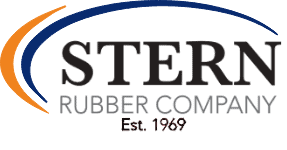This synthetic rubber is a copolymer of acrylonitrile (ACN) and Butadiene, and tends to have a resistance to oil, fuel and other chemicals. The higher the nitrile (ACN) content, the more resistant to oil this rubber becomes. Some of the trade names used at Stern Rubber Company for nitrile rubber include Krynac, Nipol and Perbunan, but nitrile-butadiene rubber is most commonly referred to as NBR, Buna-N, or just simply nitrile. Nitrile is commonly used in the automotive and aeronautical industry; products that have good oil resistance include oil handling hoses, grommets and seals. A common use for nitrile is disposable gloves, which includes the nuclear industry where nitrile gloves work the best, nitrile rubber is three times more puncture resistant than natural rubber gloves. One product that is a solid example of Stern Rubber Company’s use of NBR is Shinola’s watchbands, which are a combination of nitrile and PVC.
Like other synthetic elastomers, nitrile rubber was used extensively during World War II and was invented 1934 by Erich Konrad and Eduard Tschunkur, who were German chemists. These chemists worked for a world’s largest concern or cartel of chemical plants called IG Farben, which is Interessengemeinschaft Farbenindustrie Aktiengesellschaft which was founded in 1925. During World War II, IG Farben created a plant at Auschwitz to take advantage of Jewish slave labor and also experimented on live subjects. One of the products that IG Farben developed during the Nazi occupation of Germany is Zyklon B which was the death gas that was used to put to death millions of Jews and other undesirables. After the war, nine of the company’s officials were convicted of war crimes against humanity and at the end of the war; the allies dismantled the plant, which spelled the end of IG Farben.
The United States also produced Nitrile rubber called Buna N during World War II and was known as GR-N or Government Rubber-Nitrile. This combination of acrylonitrile-butadiene elastomers were later referred to as nitrile rubber. Since all the natural rubber supplies in the Southeast Pacific were unavailable due to the occupation of the Japanese during the war, synthetic rubbers were used to manufacture products for the war effort.
If oil resistance is a concern, than nitrile rubber is a good solution. NBR is often used here at Stern Rubber Company for automotive seals, transmission belts, gaskets, hoses, O rings, oil seals, V belts, printing rollers, cable jacketing and used in synthetic leather. Other products that work well with NBR include footwear, adhesives, sealants, expanded foams, sponges, floor mats, molded rubber and extruded rubber. The temperature range of NBR’s can withstand a range of -40⁰F to 226⁰F which makes it an ideal product for aeronautical applications. Another application for NBR’s is employed in the textile industries where it improves the finish of woven and nonwoven fabrics and has excellent waterproofing properties.
NBR is also resistant to aliphatic hydrocarbons, products of hydrogen and carbon atoms only, such as propane, methane, butane, cycle-pentane and heptane. Just like natural rubber, nitrile can be attacked by ozone, esters, ketones and aldehydes. Stern Rubber Company compounds and mills nitrile rubber at our facility in Staples, Minnesota, and our engineering department can create a formula that will suit your needs for any of your rubber projects.
